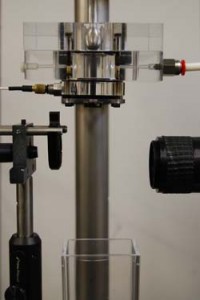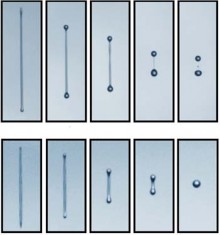Glassjet
Conventional ink-jet printing technology is restricted to low temperature printable materials, such as polymer solutions and solder. Glasses, with their durability and excellent optical, mechanical and electrical properties, underlie most of the important applications of photonics and electronics, from communications through displays and biomedicine to dielectrics in integrated circuits.
In some micro-geometries, they are readily formed, and this has resulted in their dominance in some well-known applications, e.g. in optical fibre transmission, where the cylindrical structure of the fibre lends itself naturally to fibre drawing. In general, though, glasses are not easy to form in small
The concept of glassjet printing, in which a melt is processed to give defined microstructures in the same way as inks and solutions, is intriguing and potentially far-reaching. A direct-write technology that includes glass as a printable material will contribute not only improved stability, optical and dielectric properties, but also semiconducting glasses with mobilities comparable to many polymers, potentially creating a robust and complete electronic and photonic system. The fabrication of complex structures would be transformed from a slow lithographic/etch process, restricted to planar substrates, into a versatile rapid prototyping technology that can operate on 3-D structures, serving the needs of both researchers and industry.structures, and a new technique for doing so would be dramatic in its impact. We propose to take a leap forward and create a new and flexible fabrication platform capable of realising glass microstructures down to the sub-micron domain: the glassjet printer. This project, supported by EPSRC, is a collaboration with the University of Southampton (the lead organisation) and with the Department of Applied Mathematics and Theoretical Physics at Cambridge. In this research we are exploring the challenges involved in depositing inorganic glasses by ink-jet processes.
 |
 |
| Figure 1 is the experimental setup used for the study of the jetting of highly viscous fluids and for the generation of liquid filaments. | Figure 2 shows two examples of the symmetric filaments generated with the setup of Figure1, and their time evolution. Depending on the physical properties of the fluid and initial shape, the filament will breakup or condense into a single droplet. |









